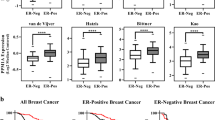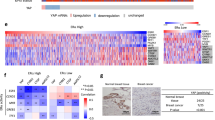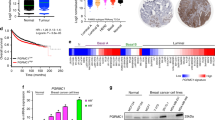Abstract
Protein tyrosine phosphatase γ (PTPγ) is a member of the receptor-like family of tyrosine phosphatases and has been implicated as a tumor suppressor gene in kidney and lung cancers. Based on our previous findings, we hypothesize that PTPγ is a potential estrogen-regulated tumor suppressor gene in human breast cancer. To examine the effects of PTPγ on growth of MCF-7 human breast cancer cells and compare the estrogenic responses of human breast cells with different PTPγ expression levels, we established several stably transfected MCF-7 cell lines expressing different levels of PTPγ, which were confirmed by RT–PCR and immunostaining. In our work, we used the antisense construct to breakdown endogenous PTPγ level in MCF-7 cells. The results from doubling time assay suggested that PTPγ is capable of inhibiting MCF-7 breast cancer cell growth. We further demonstrated that PTPγ is able to inhibit anchorage-independent growth of breast cancer cells in soft agar and reduce the estrogenic responses of MCF-7 cell proliferation to estradiol-17β (E2) and zeranol (Z, a nonsteroidal growth promoter with estrogenic activity). Our data suggest that PTPγ may function as an important modulator in regulating the process of tumorigenesis in human breast.
This is a preview of subscription content, access via your institution
Access options
Subscribe to this journal
Receive 50 print issues and online access
$259.00 per year
only $5.18 per issue
Buy this article
- Purchase on Springer Link
- Instant access to full article PDF
Prices may be subject to local taxes which are calculated during checkout






Similar content being viewed by others
References
Barnea G, Silvennoinen O, Shaanan B, Honegger AM, Canoll PD, D'Eustachio P, Morse B, Levy JB, LaForgia S, Huebner K, Musacchio JM, Sap J and Schlessinger J . (1993). Mol. Cell. Biol., 13, 1497–1506.
Gaits F, Li RY, Ragab A, Ragab-Thomas JMF and Chap H . (1995). Biochem. J., 311, 97–103.
Kaplan R, Morse B, Huebner K, Croce C, Ravera M, Ricca G, Jaye M and Schlessinger J . (1990). Proc. Natl. Acad. Sci. USA, 87, 7000–7004.
Klarlund JK . (1985). Cell, 41, 707–717.
Krop IE, Sgroi D, Porter DA, Lunetta KL, LeVangie R, Seth P, Kaelin CM, Rhei E, Bosenberg M, Schnitt S, Marks JR, Pagon Z, Belina D, Razumovic J and Polyak K . (2001). Proc. Natl. Acad. Sci. USA, 98, 9796–9801.
Krueger NX and Saito H . (1992). Proc. Natl. Acad. Sci. USA, 8, 7417–7421.
Krueger NX, Streuli M and Saito H . (1990). EMBO J., 9, 3241–3252.
Kulp SK, Liu S, Sugimoto Y, Brueggemeier RW and Lin YC . (2000). Biol. Reprod., 62 (Suppl 1), 181–182.
Laborda J . (1991). Nucleic Acids Res., 19, 3998.
LaForgia S, Lasota J, Latif F, Boghosian-sell L, Kastury K, Ohta M, Druck T, Atchison L, Cannizzaro L, Barnea G, Schlessinger J, Modi W, Kuzmin I, Tory K, Zbar B, Croce CM, Lerman M and Huebner K . (1993). Cancer Res., 53, 3118–3124.
LaForgia S, Morse B, Levy J, Barnea G, Cannizzaro LA, Li F, Nowell PC, Boghosian-sell L, Glick J, Weston A, Harris CC, Drabkin H, Patterson D, Crose CM, Schlessinger J and Huebner K . (1991). Proc. Natl. Acad. Sci. USA, 88, 5036–5040.
Levy JB, Canoll PD, Silvennoinen O, Barnea G, Morse B, Honegger AM, Huang J-T, Cannizzaro LA, Park S-H, Druck T, Huebner K, Sap J, Ehrlich M, Musacchio JM and Schlessinger J . (1993). J. Biol. Chem., 268, 10573–10581.
Lin YC, Chang CJG, Sugimoto Y, Chen R, Canatan H, Brueggemeier RW and Dayton MA . (1994). Proceedings of the American Association for Cancer Research 85th Annual Meeting, Vol. 35, 607a (Abstract #3619).
Liu S, Kulp SK, Sugimoto Y, Jiang J, Chang HL and Lin YC . (2002). Breast Cancer Res. Treat., 71, 21–35.
Lubinski J, Hadaczek P, Podolski J, Toloczko A, Sikorski A, McCue P, Druck T and Huebner K . (1994). Cancer Res., 54, 3710–3713.
Masiakowski P, Breathnach R, Bloch J, Gannon F, Krust A and Chambon P . (1982). Nucleic Acids Res., 10, 7895–7903.
Poliseno L, Mariani L, Collecchi P, Piras A, Zaccaro L and Rainaldi G . (2002). Cancer Chemother. Pharmacol., 50, 127–130.
Shock LP, Bare DJ, Klinz PF and Maness PF . (1995). Mol. Brain Res., 28, 110–116.
Sorio C, Melotti P, D'Arcangelo D, Mendrola J, Calabretta B, Croce CM and Huebner K . (1997). Blood, 90, 49–57.
Sorio C, Mendrola J, Lou Z, Laforgia S, Croce CM and Huebner K . (1995). Cancer Res., 55, 4855–4864.
Tsukamoto T, Takahashi T, Ueda R, Hibi K, Saito H and Takahashi T . (1992). Cancer Res., 51, 3506–3509.
van Niekerk CC and Poels LG . (1999). Cancer Lett., 137, 61–73.
Zheng J, Kulp SK, Zhang Y, Sugimoto Y, Dayton MA, Govindan MV, Brueggemeier RW and Lin YC . (2000). Anticancer Res., 20, 11–20.
Acknowledgements
This study was supported by Department of Defense Breast Cancer Research Program Grants DAMD 8140 and 9341, and NIH Grants CA 94718 and CA 95915. MIUR 60%, Fondazione Cassa di Risparmio di Verona (Bando 2001) and Consorzio per gli Studi Universitari in Verona, Italy. We thank Dr Kay Huebner for the critical reading of this manuscript.
Author information
Authors and Affiliations
Corresponding author
Rights and permissions
About this article
Cite this article
Liu, S., Sugimoto, Y., Sorio, C. et al. Function analysis of estrogenically regulated protein tyrosine phosphatase γ (PTPγ) in human breast cancer cell line MCF-7. Oncogene 23, 1256–1262 (2004). https://doi.org/10.1038/sj.onc.1207235
Received:
Revised:
Accepted:
Published:
Issue Date:
DOI: https://doi.org/10.1038/sj.onc.1207235
Keywords
This article is cited by
-
Loss of RPTPγ primes breast tissue for acid extrusion, promotes malignant transformation and results in early tumour recurrence and shortened survival
British Journal of Cancer (2022)
-
A new monoclonal antibody detects downregulation of protein tyrosine phosphatase receptor type γ in chronic myeloid leukemia patients
Journal of Hematology & Oncology (2017)
-
Aberrant PTPRO methylation in tumor tissues as a potential biomarker that predicts clinical outcomes in breast cancer patients
BMC Genetics (2014)
-
Comprehensive characterization of cancer subtype associated long non-coding RNAs and their clinical implications
Scientific Reports (2014)
-
Analysis of BMP4 and BMP7 signaling in breast cancer cells unveils time-dependent transcription patterns and highlights a common synexpression group of genes
BMC Medical Genomics (2011)



